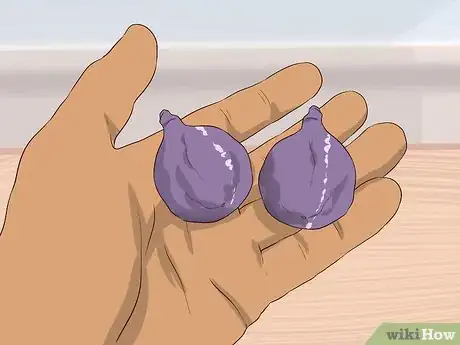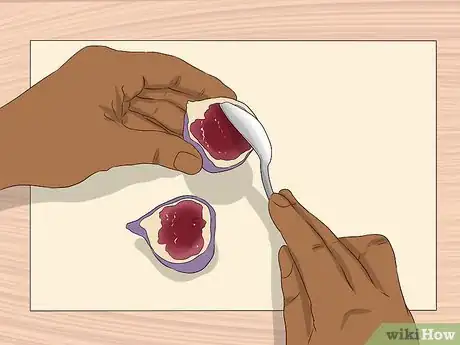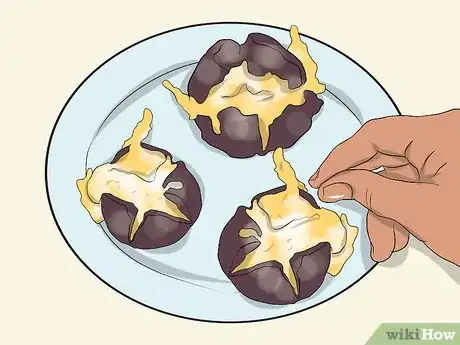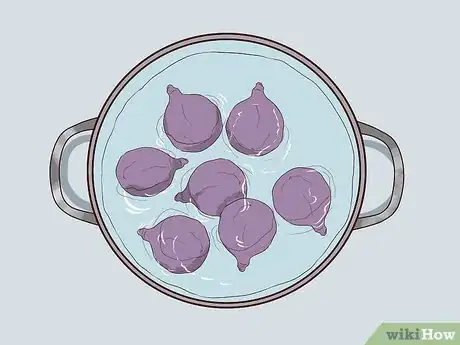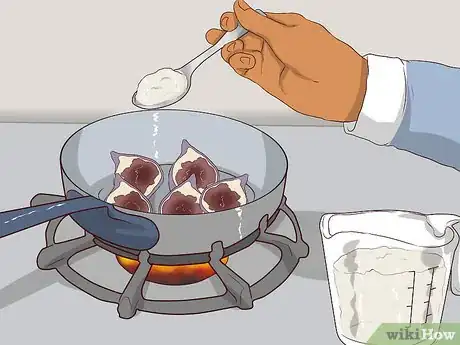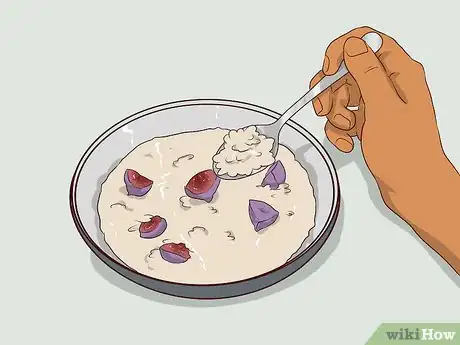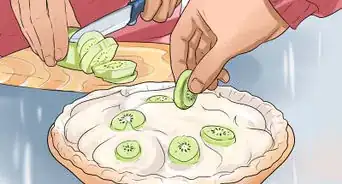wikiHow is a “wiki,” similar to Wikipedia, which means that many of our articles are co-written by multiple authors. To create this article, 25 people, some anonymous, worked to edit and improve it over time.
There are 7 references cited in this article, which can be found at the bottom of the page.
This article has been viewed 1,037,553 times.
Learn more...
Figs have a mildly sweet taste and a notably sweet aroma. They are most popular when dried, but fresh figs are also quite tasty. You can enjoy figs on their own, or pair them with other foods, such as dairy products, spiced wine, or cakes. This wikiHow will offer you some guidelines on the best ways to eat a fig.
Steps
Choosing and Preparing Figs
-
1Eat figs fresh or dried. Figs are sensitive to cold temperatures and difficult to transport, so it can be hard to find fresh figs in cooler climates, especially outside of summer. Dried figs are available in most grocery stores year-round, however.
- Figs are healthy no matter how you consume them. There are 37 calories for every 8 oz (50 g), and the same amount yields an average of 1.45 g fiber, 116 mg potassium, 0.06 mg manganese, and 0.06 mg vitamin B6.[1]
-
2Choose ripe figs for consumption. The exact size and color of a ripe fig varies based on the variety, but all varieties are soft when ripe. A ripe fig will give when poked and will have a very potent, sweet smell.
- Avoid figs that are hard or ones that have deep rips or bruises. A few small scratches are fine, however, since these will not affect the taste or quality of the fruit.
- Also avoid figs that appear to have mold on them or those that smell sour or rotten.
- Ripe figs can be green, brown, yellow, or deep purple.
- You should use figs as fresh as possible. They can be stored in the refrigerator for 2 or 3 days after harvest but will begin to spoil past that point. You can preserve figs by freezing them or canning them if you need to keep them longer.
Advertisement -
3Clean fresh figs before eating them. Rinse the figs under cool water and gently wipe them dry with clean paper towels.[2]
- Since figs are so delicate, you should never scrub them with a vegetable brush. Remove any dirt you see by scrubbing it gently with your fingers.
- Remove the stems as you wash the figs by gently twisting them off using your fingers.
-
4Remove any sugar crystals. Sugar crystals can be removed by sprinkling 1/2 cup (125 ml) figs with 1 tsp (5 ml) water and microwaving them on high for 1 minute.
- Ripe figs often ooze a sugary syrup that can crystallize on the surface. These figs are still good to eat, but for presentation or texture purposes these crystals are usually removed.
Eating Fresh Figs
-
1Eat whole. Figs have a mildly sweet taste and can be enjoyed fresh and on their own.
- The skin of the fig is edible. As a result, you do not need to peel the fig before eating it. Merely twist off the stem and eat the fig skin and all.
- If you do not like the texture of the skin, you can peel it off before eating the fig. After twisting off the stem, carefully use your fingers to peel away the skin starting from the exposed top.
- To enjoy the flavor of the interior without removing the skin, simply cut the fig in half. Gently hold the fig with one hand and use a sharp knife to cut it in half lengthwise. This exposes the sweet interior, allowing the taste to come forth immediately as soon as you eat it.
-
2Serve figs with a tangy cheese product. A common way to serve fresh figs is to enjoy them raw with a little cheese or dairy spread over them. The dairy should be sweet and tangy, however, rather than sharp.
- Cut the figs in half and place a dollop of cream cheese over each half.[3] You could use plain cream cheese or flavored cream cheese. This can be served as a snack or simple appetizer.
- Melt a piece of blue cheese into the fig. Remove the stems and cut a small "x" shape in the top of the fig. Stuff a bit of blue cheese into the cut and bake for 10 minutes at 400 degrees Fahrenheit (204 degrees Celsius).
- Rich dairy products, like mascarpone and crème fraiche, also work well with the flavor of figs.
-
3Poach the figs. Figs can be poached on the stove or in a slow cooker. Use roughly 2 cups (500 ml) of liquid for every 8 figs.
- You could use fortified wine or wine that has been simmered with warm spices, like cinnamon, cloves, or star anise. You could also use fruit juice or flavored vinegar like balsamic vinegar.
- Simmer the figs for 10 to 15 minutes on the stove.[4]
- Cook the figs on low for 2 to 3 hours in the slow cooker.[5]
- Poached figs are often served with yogurt, rich dairy products, or frozen desserts.
-
4Use as preserves. Mix 1 lb (450 g) chopped figs with 1 cup (250 ml) sugar in a saucepan. Cook on low heat for 30 minutes until thick preserves form.[6]
-
5Use in baked goods. Figs can be used in breads, cakes, muffins, and other flour-based baked goods.
- Mix with other fruits. For instance, you could add chopped figs to your favorite peach cobbler recipe or add figs to raspberry, lemon, or orange-flavored pies and desserts.
- Make figs the center of attention. You can also have baked goods that completely rely on the flavor of figs, rather than pairing figs with other fruits. You could make a fig tart or bake chopped figs into a pound cake or yogurt cake.
- Use as a garnish. Halved or quartered figs make an appealing garnish for cakes and similar desserts. They work especially well on cakes made with rich frostings, like cream cheese frosting, or on cakes flavored with nuts, like an almond cake.[7]
Consuming Dried Figs
-
1Enjoy as-is. Dried figs can be eaten plain, just like raisins or other dried fruits. This is one of the simplest ways to enjoy the fruit as a snack.
-
2Rehydrate the figs. When using dried figs for recipes, you may find it beneficial to rehydrate them so that they become juicier and plumper.
- You can soak dried figs in water or fruit juice overnight.
- A more thorough method of rehydrating figs is to simmer them for several minutes in water or fruit juice.
- When using either method, add just enough liquid to cover the layer of figs.
-
3Use in baked goods. Both dried and rehydrated figs can be used in baked good recipes.
- Gravitate toward breads, cakes, muffins, and cookies over pies and tarts. Mix the dried figs into the batter of these flour-based baked goods before baking.
- Replace other dried fruits with dried figs. Instead of making oatmeal raisin cookies, make oatmeal fig cookies. Instead of adding dried tart cherries to a muffin batter, add dried figs.
-
4Add to oatmeal or porridge. Another simple way to enjoy dried figs is to simply sprinkle a few over hot breakfast cereal. The figs will add a mildly sweet boost of flavor.
-
5Stir some into cottage cheese or yogurt. For a light lunch, you could mix a handful of dried figs into a serving of cottage cheese or yogurt. These rich, tangy dairy products complement the taste of figs rather well.
Community Q&A
Did you know you can get answers researched by wikiHow Staff?
Unlock staff-researched answers by supporting wikiHow
-
QuestionDo all figs have wasps in them?
 wikiHow Staff EditorThis answer was written by one of our trained team of researchers who validated it for accuracy and comprehensiveness.
wikiHow Staff EditorThis answer was written by one of our trained team of researchers who validated it for accuracy and comprehensiveness.
Staff Answer wikiHow Staff EditorStaff AnswerNo, not all figs have wasps in them, though it's a common misconception. Some varieties of figs ripen without needing to be pollinated by a wasp and it's also possible to cause figs to ripen with hormones so no wasp is needed. For these reasons, most commercially grown figs actually never come into contact with wasps. If a fig is grown with wasps, a chemical called ficin breaks down the wasp and the fig absorbs it, so you won't ever come across any wasp parts in a fig.
wikiHow Staff EditorStaff AnswerNo, not all figs have wasps in them, though it's a common misconception. Some varieties of figs ripen without needing to be pollinated by a wasp and it's also possible to cause figs to ripen with hormones so no wasp is needed. For these reasons, most commercially grown figs actually never come into contact with wasps. If a fig is grown with wasps, a chemical called ficin breaks down the wasp and the fig absorbs it, so you won't ever come across any wasp parts in a fig. -
QuestionHow do you know when a fig is ripe to eat?
 wikiHow Staff EditorThis answer was written by one of our trained team of researchers who validated it for accuracy and comprehensiveness.
wikiHow Staff EditorThis answer was written by one of our trained team of researchers who validated it for accuracy and comprehensiveness.
Staff Answer wikiHow Staff EditorStaff Answer
wikiHow Staff EditorStaff Answer -
QuestionWhat do you do with fresh figs?
 wikiHow Staff EditorThis answer was written by one of our trained team of researchers who validated it for accuracy and comprehensiveness.
wikiHow Staff EditorThis answer was written by one of our trained team of researchers who validated it for accuracy and comprehensiveness.
Staff Answer wikiHow Staff EditorStaff Answer
wikiHow Staff EditorStaff Answer
Warnings
- Consult with your doctor before eating figs if you have had serious kidney problems in the past. They contain oxalates, a natural substance that can be harmful when it builds up in the body's blood. The kidneys usually filter this substance out, but unhealthy kidneys are unable to do so.⧼thumbs_response⧽
Things You'll Need
- Paper towels
- Knife
References
- ↑ http://www.whfoods.com/genpage.php?tname=foodspice&dbid=24
- ↑ http://www.myrecipes.com/how-to/video/preparing-fresh-figs-10000001847743/
- ↑ http://www.chezbettay.com/pages/lunches_snacks_sandwiches1/lss_figs.html
- ↑ http://www.marthastewart.com/281951/spiced-poached-figs
- ↑ http://www.huffingtonpost.com/2012/03/30/poached-figs-with-blackbe_n_1391465.html
- ↑ http://www.foodnetwork.com/recipes/emeril-lagasse/fig-preserves-recipe/index.html
- ↑ http://www.huffingtonpost.com/2012/07/27/fresh-fig-recipes_n_1706017.html#slide=1282723
About This Article
If you want to eat a fresh fig, choose one that smells very sweet and gives slightly when you press on it to ensure that it’s ripe. Rinse the fig under cool water and gently pat it dry with clean paper towels. You can then eat your fresh figs whole, including the skin, or you can serve them with a tangy cheese like mascarpone or melted blue cheese. You can also poach figs in water, simmer them with sugar until they thicken into a preserve, or mix them into your favorite baked goods. For tips on eating dried figs, read on!

